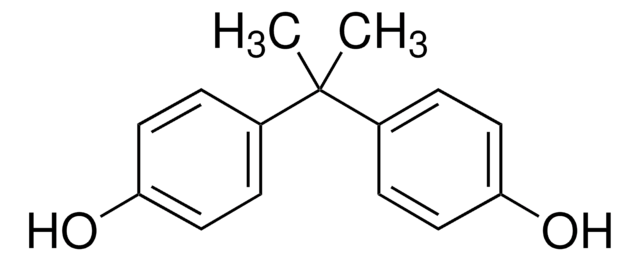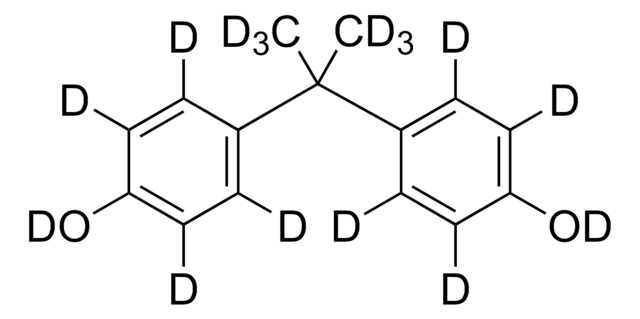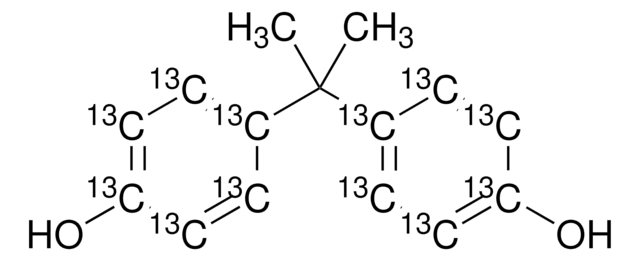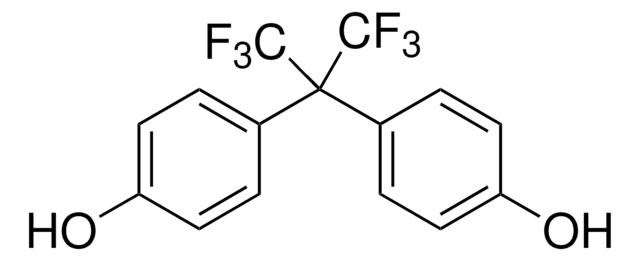Kluczowe dokumenty
42088
Bisphenol A
certified reference material, TraceCERT®, Manufactured by: Sigma-Aldrich Production GmbH, Switzerland
Synonim(y):
2,2-Bis(4-hydroxyphenyl)propane, 4,4′-Isopropylidenediphenol
About This Item
Polecane produkty
klasa czystości
certified reference material
TraceCERT®
Poziom jakości
okres trwałości
limited shelf life, expiry date on the label
producent / nazwa handlowa
Manufactured by: Sigma-Aldrich Production GmbH, Switzerland
metody
HPLC: suitable
gas chromatography (GC): suitable
bp
220 °C/4 mmHg (lit.)
mp
158-159 °C (lit.)
Zastosowanie
cleaning products
cosmetics
environmental
food and beverages
personal care
Format
neat
ciąg SMILES
CC(C)(c1ccc(O)cc1)c2ccc(O)cc2
InChI
1S/C15H16O2/c1-15(2,11-3-7-13(16)8-4-11)12-5-9-14(17)10-6-12/h3-10,16-17H,1-2H3
Klucz InChI
IISBACLAFKSPIT-UHFFFAOYSA-N
Szukasz podobnych produktów? Odwiedź Przewodnik dotyczący porównywania produktów
Opis ogólny
Certified content by quantitative NMR incl. uncertainty and expiry date are given on the certificate.
Download your certificate at: http://www.sigma-aldrich.com.
Zastosowanie
Inne uwagi
The collision cross section (CCS) measurement was provided by Waters Corporation, using the SYNAPT XS mass spectrometer.
For a description and overview of how ion mobility enables the measurement of the CCS of an ion visit ims.waters.com.
Further information on the SYNAPT XS mass spectrometer can be found on the IMS microsite and product webpage.
TWCCS measurements are expected to be within 2% of this reference value.
P/N 42088 is part of the Waters Extractables & Leachables UNIFI scientific library which can be downloaded from Waters Marketplace.
Polecane produkty
Informacje prawne
Hasło ostrzegawcze
Danger
Zwroty wskazujące rodzaj zagrożenia
Zwroty wskazujące środki ostrożności
Klasyfikacja zagrożeń
Aquatic Acute 1 - Aquatic Chronic 1 - Eye Dam. 1 - Repr. 1B - Skin Sens. 1 - STOT SE 3
Organy docelowe
Respiratory system
Kod klasy składowania
6.1C - Combustible acute toxic Cat.3 / toxic compounds or compounds which causing chronic effects
Klasa zagrożenia wodnego (WGK)
WGK 3
Temperatura zapłonu (°F)
440.6 °F - closed cup
Temperatura zapłonu (°C)
227 °C - closed cup
Wybierz jedną z najnowszych wersji:
Certyfikaty analizy (CoA)
Nie widzisz odpowiedniej wersji?
Jeśli potrzebujesz konkretnej wersji, możesz wyszukać konkretny certyfikat według numeru partii lub serii.
Masz już ten produkt?
Dokumenty związane z niedawno zakupionymi produktami zostały zamieszczone w Bibliotece dokumentów.
Klienci oglądali również te produkty
Protokoły
Bisphenol A (BPA) is suspected to be an endocrine disruptor. Regulations on specific migration limits (SML) from food contact materials are getting tighter (EU 2018/213) requiring more sensitive determinations. An overcoated SPME fiber provides the durability necessary for direct immersion into foods such as canned soup and pumpkin, allowing for low level analysis of BPA via SPME-GC-MS/MS.
Separation of Bisphenol A, ≥99%
HPLC Analysis of Bisphenol A, Dimethylbisphenol A and Nonylphenol on Ascentis® Express RP-Amide (UV Detection)
Powiązane treści
GC/MS/MS Analysis of Bisphenol A (BPA) in a Fruit Flavored Energy Drink on the SLB-PAHms Column After SPME Using an Overcoated SPME Fiber
Nasz zespół naukowców ma doświadczenie we wszystkich obszarach badań, w tym w naukach przyrodniczych, materiałoznawstwie, syntezie chemicznej, chromatografii, analityce i wielu innych dziedzinach.
Skontaktuj się z zespołem ds. pomocy technicznej












